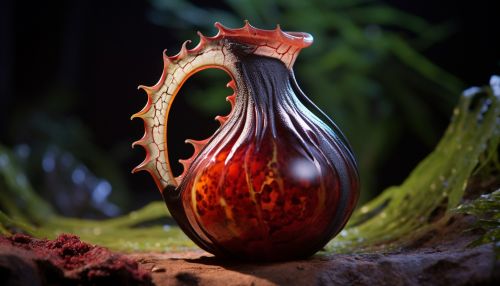Nepenthes
Introduction
Nepenthes, also known as tropical pitcher plants or monkey cups, are a genus of carnivorous plants in the family Nepenthaceae. They are characterized by their unique pitcher-shaped leaves, a modification of the leaf tip, which are used to trap and digest insects. The genus comprises about 170 species, and numerous hybrids and cultivars, and is widely distributed across the Old World tropics.
Description
Nepenthes are climbing plants, with tendrils that extend from the midrib of the leaf. The end of the tendril forms the pitcher, which is actually a specialized leaf structure. The pitcher starts as a small bud and gradually expands to form a globe- or tube-shaped trap.
The trap contains a fluid of the plant's own production, which may be watery or syrupy and is used to drown the prey. The lower part of the trap contains glands which absorb nutrients from captured prey. Along the upper inside part of the trap is a slick, waxy coating which makes the escape of its prey nearly impossible.
Distribution and Habitat
Nepenthes are native to the Old World tropics, spanning a range from South China, Indonesia, Malaysia and the Philippines; westward to Madagascar (two species) and the Seychelles (one); southward to Australia (three) and New Caledonia (one); and northward to India (one) and Sri Lanka (one). They also occur in eastern Australia, India, Madagascar and Seychelles. They usually grow in rainforest environments, but can also be found in a variety of other habitats such as heath forest, swamps, and even montane mossy forest.
Taxonomy
The genus Nepenthes was first described by Carl Linnaeus in 1753, in his work Species Plantarum. The name is derived from the Greek words 'nepenthes', which means 'without sorrow'. Linnaeus explained that he chose this name in reference to the intoxicating properties of the plant's distilled juices.
Cultivation
Nepenthes are popular as ornamental plants and are often grown by hobbyists. They can be grown both indoors and outdoors in climates that do not experience freezing temperatures. They require high humidity, bright but indirect light, and a well-draining growing medium that is low in nutrients.
Conservation
Many species of Nepenthes are threatened due to habitat loss and over-collection. Several species are listed as endangered or critically endangered on the IUCN Red List. Conservation efforts include habitat preservation, cultivation for the horticultural trade, and tissue culture propagation.
See Also


